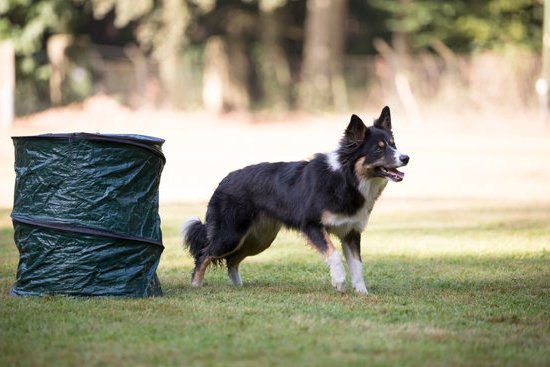Are you struggling with training your dog to respect boundaries and stay within a fenced area? In this article, we will explore the need for training through a fence and provide tips on how to effectively train your furry friend.
Training a dog through a fence can be challenging, but with the right approach and techniques, it is definitely achievable. Whether you are looking to keep your dog safe in your yard or at a public park, proper training is essential for their well-being and your peace of mind.
In the following sections, we will discuss how to choose the right type of fence for training, setting up the training area, introducing your dog to the fence, using positive reinforcement techniques, and addressing challenges that may arise during the process. We will also touch upon the importance of consistency and patience in training, as well as achieving gradual progress and eventual success.
Let’s dive into the world of training dogs through fences and learn how to do it effectively.
Choosing the Right Fence for Training
When it comes to training a dog through a fence, the first step is to choose the right type of fence for your specific needs. Not all fences are created equal, and different designs and materials can affect the success of your training efforts.
One important factor to consider is the visibility of the fence – it’s crucial that your dog can see through the barrier in order to understand their boundaries. Chain link or wire fences are often a good choice for this reason, as they allow dogs to visually understand where they can and cannot go.
Another important consideration when choosing a fence for training is its height. Depending on the size and breed of your dog, you may need a taller fence to prevent them from jumping over it. Additionally, if you live in an area with potential predators, such as coyotes or bears, it’s important to choose a fence that can keep both your dog in and potential threats out.
It’s also important to ensure that any gaps or spaces in the fence are small enough to prevent your dog from squeezing through or getting stuck. Being aware of these considerations will help you select the most appropriate type of fence for effectively training your dog.
| Consideration | Important Points |
|---|---|
| Visibility | Choose a fence that allows your dog to see through it |
| Height | Consider the size and breed of your dog when selecting fence height |
| Gaps | Select a fence design with small enough gaps to prevent squeezing through |
Setting Up the Training Area
When it comes to training your dog through a fence, one of the most crucial steps is setting up the training area. This involves creating a space where your dog can safely interact with the fence while learning boundaries and behaviors.
Choosing the Right Location
Before setting up the training area, it’s important to choose the right location for this purpose. Look for an area in your yard that is relatively quiet and free from distractions, as this will help your dog focus on the training. Additionally, ensure that the area is secure and enclosed, providing a safe environment for both you and your dog.
Creating Boundaries
Once you have identified the location, it’s time to create clear boundaries within the training area. This may involve using temporary fencing or visual markers to define the space where your dog will be interacting with the fence. By clearly delineating these boundaries, you can help your dog understand where they are expected to stay during the training process.
Providing Adequate Supervision
As you set up the training area, be sure to provide adequate supervision for your dog. While some independence can be beneficial for their learning process, it’s important to monitor their behavior and reactions to being near or interacting with the fence. This will allow you to intervene if necessary and provide guidance as needed.
By carefully planning and setting up the training area, you can create an optimal environment for teaching your dog how to interact with a fence in a positive and productive manner.
Introducing and Familiarizing Your Dog With the Fence
Introducing your dog to a fence can be a significant learning experience for them. The key is to make the process as stress-free and positive as possible, ensuring that your dog feels comfortable and safe within their new boundaries. The first step is to allow your dog to familiarize themselves with the fence. Take your time during this stage so that they have ample opportunity to explore and understand their limitations.
One effective way of introducing your dog to the fence is by taking them on regular walks around the perimeter of the designated area. This will help them become accustomed to their new surroundings and understand where their boundaries lie. It’s important to stay patient during this period, as some dogs may take longer than others to adapt.
Positive reinforcement techniques are crucial during this phase of training. Whenever your dog respects the limit set by the fence or shows signs of understanding its purpose, reward them with plenty of praise, treats, or playtime. This will help create a positive association with the fence, making it far more likely that they’ll respect it in the future.
| Training Method | Effectiveness |
|---|---|
| Regular walks around perimeter | Highly effective in familiarizing dogs with boundaries |
| Positive reinforcement techniques | Crucial in creating a positive association with the fence |
Remember, every dog is different, so it’s essential to monitor their progress closely and adjust your training methods accordingly. By being patient, consistent, and employing positive reinforcement techniques, you can successfully introduce and familiarize your dog with the fence in no time.
Using Positive Reinforcement Techniques
Positive reinforcement is an essential aspect of training a dog through a fence. This technique involves rewarding your dog for exhibiting the desired behavior, which can help them understand what is expected of them and encourage them to repeat it. Here are some positive reinforcement techniques to effectively train your dog through a fence:
- Offering treats: Using small, tasty treats can be a great way to reward your dog for staying within the boundaries of the fence or following commands.
- Verbal praise: Dogs respond well to verbal praise, so make sure to offer enthusiastic and encouraging words when they exhibit the desired behavior.
- Physical affection: Many dogs respond positively to physical affection such as petting, belly rubs, or playtime as a form of reward.
It’s important to use these positive reinforcement techniques consistently and immediately after your dog exhibits the desired behavior. This will help them associate the action with the reward and reinforce their understanding of what is expected of them.
In addition to using positive reinforcement techniques, it’s also important to avoid using punishment-based methods when training your dog through a fence. Punishment can create fear and anxiety in your dog, which can lead to unwanted behaviors and setbacks in the training process. Instead, focus on rewarding good behavior and redirecting or ignoring unwanted behavior to effectively train your dog through a fence.
Addressing Challenges and Obstacles
Recognizing Common Challenges
When training a dog through a fence, it is important to anticipate common challenges that may arise. These challenges may include the dog feeling anxious or scared when confined by the fence, attempting to escape, or exhibiting signs of frustration. Recognizing these challenges will allow you to address them effectively and tailor your training approach accordingly.
Techniques for Overcoming Challenges
One effective technique for overcoming challenges when training a dog through a fence is desensitization. Gradually expose your dog to the presence of the fence and provide positive reinforcement when they display calm behavior near it. Another technique is to create a positive association with the fenced area by playing games, providing treats, and engaging in interactive activities within the designated training space.
Seeking Professional Help
If you encounter difficulties in training your dog through a fence, do not hesitate to seek professional help. A certified dog trainer or animal behaviorist can offer valuable insights and practical solutions tailored to your specific situation. They can assess any underlying issues contributing to the challenges and provide guidance on how to address them effectively. Consulting with a professional can ensure that you are equipped with the knowledge and resources needed to train your dog successfully through the fence.
Consistency and Patience in Training
Training a dog through a fence requires consistency and patience to achieve success. Consistency is crucial in reinforcing the training and ensuring that your dog understands the boundaries set by the fence. It is important to consistently use the same commands, signals, and rewards during training sessions. Without consistency, your dog may become confused and unsure of what is expected of them.
Patience is also essential when training a dog through a fence. Some dogs may take longer to understand the boundaries and rules, so it is important to remain patient throughout the process. Rushing the training or becoming frustrated can lead to setbacks in your dog’s progress. Remember that every dog learns at their own pace, so patience is key to successful training.
To maintain consistency and patience during training, consider the following tips:
1. Create a daily training schedule: Set aside time each day for training sessions with your dog. Consistency in scheduling helps reinforce the learning process.
2. Use clear and consistent commands: Establish clear verbal cues and hand signals to communicate with your dog through the fence. Use these consistently during training sessions.
3. Reward positive behavior: Use positive reinforcement techniques such as treats, praise, or toys to reward your dog for following the rules and boundaries of the fence.
4. Stay calm and composed: Dogs can pick up on their owner’s emotions, so remaining calm and patient during training can help create a positive learning environment.
By maintaining consistency and patience in your training efforts, you can effectively teach your dog how to navigate and respect boundaries through a fence.
Gradual Progress and Achieving Success
In conclusion, training a dog through a fence is a process that requires patience, consistency, and the use of positive reinforcement techniques. It is essential for pet owners to understand the need for such training, especially if their dogs tend to escape or misbehave when within the confines of a fenced area. Choosing the right type of fence and setting up the training area plays a crucial role in successfully training your dog.
Introducing and familiarizing your dog with the fence is an important step that cannot be rushed. Using positive reinforcement techniques such as treats, toys, and praise can help encourage your dog to stay within the designated area. It is also important to address challenges and obstacles that may arise during training, making adjustments as needed to ensure progress.
Overall, achieving success in training a dog through a fence requires gradual progress and consistent efforts from the pet owner. With time and dedication, dogs can learn to respect boundaries and stay within the confines of their designated areas. By following these steps and staying patient throughout the process, pet owners can effectively train their dogs through a fence while building a strong bond with their furry companions.
Frequently Asked Questions
How Do You Train a Dog to Use a Fence?
Training a dog to use a fence involves positive reinforcement and consistency. Start by introducing the dog to the fence in a calm environment, using treats and praise to encourage them to stay within the boundaries.
How Do I Stop My Dogs From Fighting Through the Fence?
To stop dogs from fighting through the fence, it’s important to address the underlying reasons for the aggression. This may involve training, behavior modification, or removing triggers that lead to fighting.
How Long Does It Take for a Dog to Get Used to Invisible Fence?
The length of time it takes for a dog to get used to an invisible fence varies based on the individual dog. Some dogs may adapt quickly within a few days, while others may take several weeks of consistent training and reinforcement before feeling comfortable with the boundaries.

Welcome to the blog! I am a professional dog trainer and have been working with dogs for many years. In this blog, I will be discussing various topics related to dog training, including tips, tricks, and advice. I hope you find this information helpful and informative. Thanks for reading!





